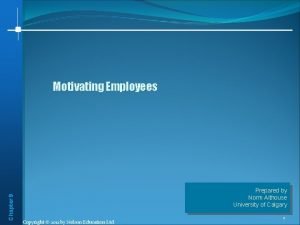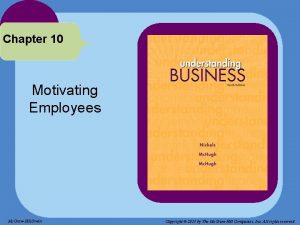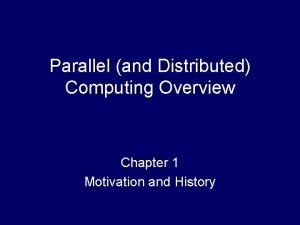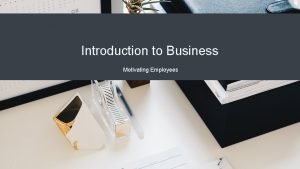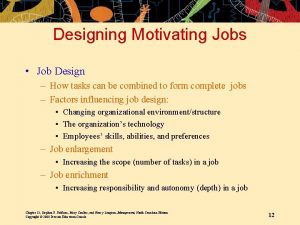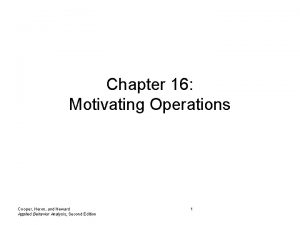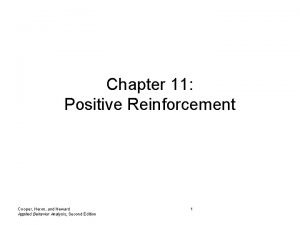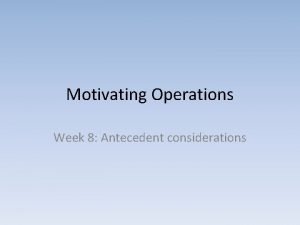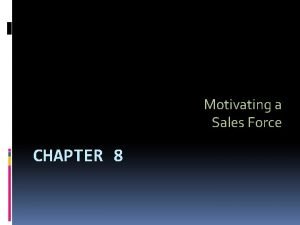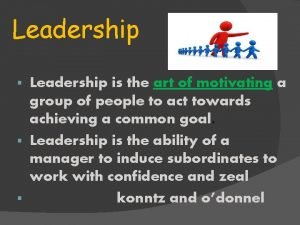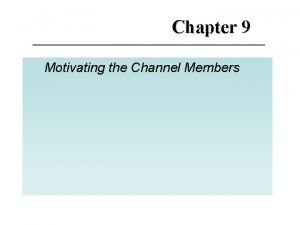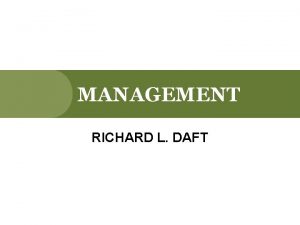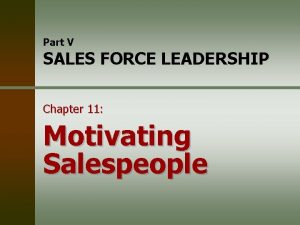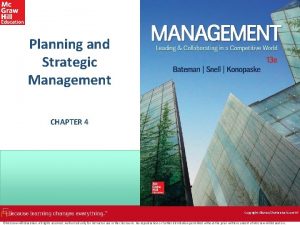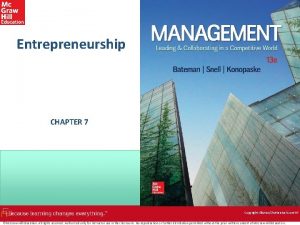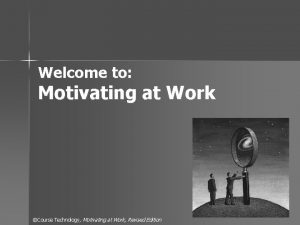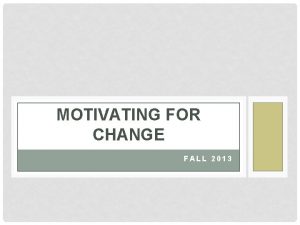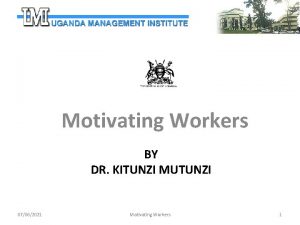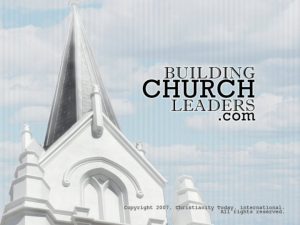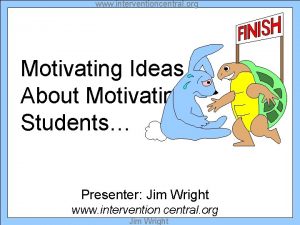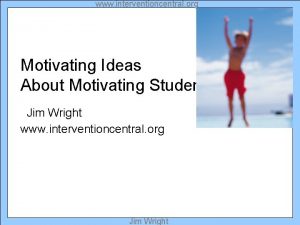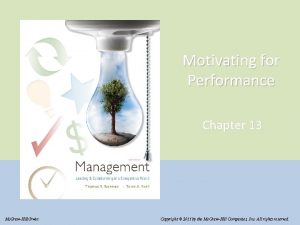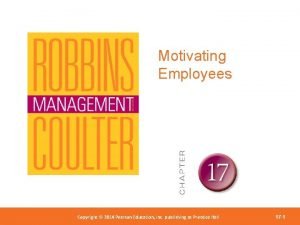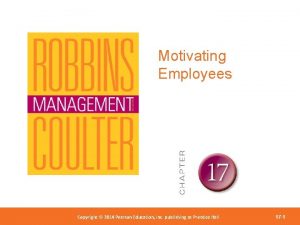Motivating for Performance CHAPTER 13 Copyright zlikovecShutterstock com


























- Slides: 26

Motivating for Performance CHAPTER 13 Copyright zlikovec/Shutterstock. com RF ©Mc. Graw-Hill Education. All rights reserved. Authorized only for instructor use in the classroom. No reproduction or further distribution permitted without the prior written consent of Mc. Graw-Hill Education.

Chapter Introduction Quotes “The worst mistake a boss can make is not to say well done. ” John Ashcroft “The reward of a thing well done is to have done it. ” Ralph Waldo Emerson ©Mc. Graw-Hill Education.

Learning Objectives 1 Identify the kinds of behaviors managers need to motivate in people. 2 List principles for setting goals that motivate employees. 3 Summarize how to reward good performance effectively. 4 Describe the key beliefs that affect peoples’ motivation. 5 Discuss ways in which people’s individual needs affect their behavior. 6 Define ways to create jobs that motivate. 7 Summarize how people assess fairness and how to achieve fairness. 8 Identify causes and consequences of a (dis)satisfied workforce. ©Mc. Graw-Hill Education.

Motivating for Performance Motivation • Forces that energize, direct, and sustain a person’s efforts Managers must motivate people to: • Join the organization. • Remain in the organization. • Come to work regularly. • Perform • Exhibit good citizenship ©Mc. Graw-Hill Education.

Setting Goals Goal-setting theory • A motivation theory stating that people have conscious goals that energize them and direct their thoughts and behaviors toward a particular end Stretch goals SMART goals • Specific • Measurable • Achievable • Results-based • Time-specific • Targets that are particularly demanding but achievable ©Mc. Graw-Hill Education. SOURCE: Adapted from Shaw, K. N. , “Changing the Goal-Setting Process at Microsoft, ” Academy of Management Executive 4, November 2004, pp. 139– 43.

Reinforcing Performance Law of effect • Formulated by Edward Thorndike • Behavior followed by positive consequences will likely be repeated ©Mc. Graw-Hill Education. Four potential consequences of behavior: • Positive reinforcement • Negative reinforcement • Punishment • Extinction

Exhibit 13. 3 The Consequences of Behavior Jump to Appendix 1 for long description of image. ©Mc. Graw-Hill Education.

The Greatest Management Principle in the World Companies, and individual managers, should reward the following: 1. Solid solutions instead of quick fixes. 2. Risk taking instead of risk avoiding. 3. Applied creativity instead of mindless conformity. 4. Decisive action instead of paralysis by analysis. 5. Smart work instead of busywork. 6. Simplification instead of needless complication. 7. Quietly effective behavior instead of squeaky wheels. 8. Quality work instead of fast work. 9. Loyalty instead of turnover. 10. Working together instead of working against. ©Mc. Graw-Hill Education.

Expectancy Theory A theory proposing that people will behave based on the perceived likelihood that their effort will lead to a certain outcome that is a highly valued outcome Jump to Appendix 2 for long description of image. ©Mc. Graw-Hill Education.

Exhibit 13. 6 Maslow’s Need Hierarchy A conception of human needs organizing them into a hierarchy Needs satisfied in a specific order: 1. Physiological 2. Safety 3. Social 4. Ego 5. Self-actualization ©Mc. Graw-Hill Education. SOURCE: Organ D. , and Bateman, T. , Organizational Behavior, 4 th ed. , New York: Mc. Graw-Hill, 1991.

Alderfer’s ERG Theory A human needs theory suggesting that people have three basic sets of needs that can operate simultaneously ©Mc. Graw-Hill Education. Existence Relatedness Growth

Mc. Clelland’s Needs Different needs predominate for different people • Need for achievement • Need for affiliation • Need for power ©Mc. Graw-Hill Education. Copyright photobac/123 RF RF

Designing Motivating Jobs Extrinsic reward • Reward given to a person by the boss, the company, or some other person Intrinsic reward • Reward a worker derives directly from performing the job itself ©Mc. Graw-Hill Education. Copyright Justin Sullivan/Getty Images

Social Enterprise Giving Veterans a Renewed Sense of Purpose Staffed by veterans, Team Rubicon bridges the gap between the moment a natural disaster happens and when other aid organizations respond. • Of those veterans who would like to work for Team Rubicon, what types of rewards are likely to keep them motivated: extrinsic, intrinsic, or both? • To what degree do you think Team Rubicon will make a positive impact on natural disaster victims? ©Mc. Graw-Hill Education.

Job Rotation, Enlargement, and Enrichment Job Rotation • Changing from one task to another to alleviate boredom Job Enlargement • Giving people additional tasks at the same time to alleviate boredom Job Enrichment • Changing a task to make it inherently more rewarding, motivating, and satisfying ©Mc. Graw-Hill Education.

Herzberg’s Two-Factor Theory Hygiene factors Motivators Characteristics of the workplace, such as company policies, working conditions, pay, and supervision, that can make people dissatisfied but do not lead to motivation Factors that make a job more motivating, such as additional job responsibilities, opportunities for personal growth and recognition, and feelings of achievement ©Mc. Graw-Hill Education.

Exhibit 13. 7 The Hackman and Oldham Model Jump to Appendix 3 for long description of image. ©Mc. Graw-Hill Education. SOURCE: Hackman, J. Richard et al. , “A New Strategy for Job Enrichment, ” California Management Review 17, no. 4, Summer 1975, 57– 71.

Empowerment Sharing power with employees, enhancing their confidence in their ability to perform their jobs, and their belief that they are contributors to the organization Empowering actions include: • Increasing signature authority • Reducing rules and approval steps • Assigning nonroutine jobs • Allowing independent judgment • Defining jobs more broadly as projects • Providing access to resources ©Mc. Graw-Hill Education.

Equity Theory Your Ratio Other’s Ratio Likely Perception Your Outcomes = Your Inputs Other’s Outcomes Equitably Other’s treated. Inputs Possible action to Restore Equity No action necessary. Reduce your inputs. Try to increase your outcomes (e. g. , ask Your Other’s Inequitably for a raise). Change your Outcomes < Outcomes treated. Feel Your Other’s perception of inputs or outcomes underrewarded. Inputs (e. g. , maybe so-and-so really did deserve the bonus). Your Outcomes > Your Inputs ©Mc. Graw-Hill Education. Other’s Inequitably Outcomes treated. Feel Other overrewarded. Inputs Increase your inputs by putting in extra effort. Help other person increase her outcomes (e. g. , urge her to ask for a larger bonus).

Procedural Justice Procedural justice • Using fair process in decision making and making sure others know that the process was as fair as possible Perceptions of justices may be increased by: • Making sure the process is visible and known • Making sure decision makers are viewed as trustworthy • Allowing for participation and appeal ©Mc. Graw-Hill Education.

The Impact of Worker Dissatisfaction Higher turnover Higher absenteeism Less good citizenship among employees More grievances and lawsuits Strikes ©Mc. Graw-Hill Education. Stealing, sabotage, and vandalism Poorer mental & physical health More injuries Poor customer service Lower productivity and profits

Quality of Work Life Quality of work life (QWL) programs create a workplace that enhances employee job satisfaction and overall physical and mental well-being. ©Mc. Graw-Hill Education. Copyright SAS Software Co.

QWL Program Categories 1. Adequate and fair compensation. 2. A safe and healthy environment. 3. Jobs that develop human capacities. 4. A chance for personal growth and security. 5. An environment that fosters personal identity, freedom from prejudice, a sense of community, and upward mobility. 6. Constitutionalism, or the rights of personal privacy, dissent, and due process. 7. A work role that minimized infringement on personal leisure and family needs. 8. Socially responsible organizational actions. ©Mc. Graw-Hill Education.

Psychological Contract The contract is a set of perceptions of what employees owe their employers, and what their employers owe them. Viewing employment as an alliance is much more likely to produce a mutually beneficial and satisfying relationship and a high-performing, successful organization. ©Mc. Graw-Hill Education.

Management in Action Onward How SAS Makes Work Motivating SAS emphasizes management responsibility for employee development, a culture of trust and ensures that work is meaningful • How does SAS make its jobs motivating? What other principles of job design could enhance motivation at SAS? • What elements of SAS’s approach to motivation do you think would contribute more to job satisfaction than to performance? ©Mc. Graw-Hill Education.

In Review 1 Identify the kinds of behaviors managers need to motivate in people. 2 List principles for setting goals that motivate employees. 3 Summarize how to reward good performance effectively. 4 Describe the key beliefs that affect peoples’ motivation. 5 Discuss ways in which people’s individual needs affect their behavior. 6 Define ways to create jobs that motivate. 7 Summarize how people assess fairness and how to achieve fairness. 8 Identify causes and consequences of a (dis)satisfied workforce. ©Mc. Graw-Hill Education.
 Dậy thổi cơm mua thịt cá
Dậy thổi cơm mua thịt cá Cơm
Cơm Chapter 10 motivating employees
Chapter 10 motivating employees Chapter 10 motivating and satisfying employees and teams
Chapter 10 motivating and satisfying employees and teams Chapter 10 motivating employees
Chapter 10 motivating employees Chapter 10 motivating employees
Chapter 10 motivating employees Chapter 10 motivating employees
Chapter 10 motivating employees Motivating parallelism
Motivating parallelism Motivating students to learn english
Motivating students to learn english Ways of motivating employees
Ways of motivating employees Designing motivating jobs adalah
Designing motivating jobs adalah Examples of cmo-t
Examples of cmo-t Motivating operations examples
Motivating operations examples Motivating operations definition
Motivating operations definition Sales force motivation ppt
Sales force motivation ppt Communating
Communating Motivating channel members
Motivating channel members Staffing in management importance
Staffing in management importance Motivation for software developers
Motivation for software developers Motivating employees without money
Motivating employees without money Motivating and satisfying employees and teams
Motivating and satisfying employees and teams Introduction to parallel computing grama
Introduction to parallel computing grama Samuel de champlain motivation
Samuel de champlain motivation Motivating people for total quality
Motivating people for total quality Motivating sales force
Motivating sales force Motivating yourself and others
Motivating yourself and others Inventory of good learner repertoires
Inventory of good learner repertoires




